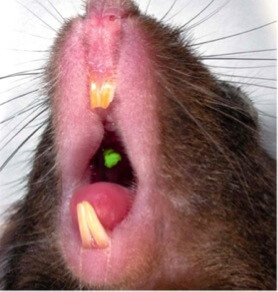Polymer scaffolds guide stem cells growth into customized sizes and shapes.
The NSU researchers’ approach is to extract stem cells from oral tissue, such as inside a tooth itself, or from bone marrow. After being harvested, the cells are mounted to a polymer scaffold in the shape of the desired tooth. The polymer is the same material used in bioreabsorable sutures, so the scaffold eventually dissolves away. Teeth can be grown separately then inserted into a patient’s mouth or the stem cells can be grown within the mouth reaching a full-sized tooth within a few months.
So far, teeth have been regenerated in mice and monkeys, and clinical trials with humans are underway, but whether the technology can generate teeth that are nourished by the blood and have full sensations remains to be seen. Teeth present a unique challenge for researchers because the stem cells must be stimulated to grow the right balance of hard tissue, dentin and enamel, while producing the correct size and shape.
As Dr. Murray explains it, humans already have two sets of teeth, baby and adult sets, over the course of their lifetimes, so “All we are trying to do is copy nature and give the person the third option to re-grow their teeth.” Not only could this be important for replacing lost teeth, but it could become a standard treatment when extreme orthodontics is necessitated. And if the tooth is malformed or fails, it can be extracted and a new one put into place.
To date, the NSU researchers have received about $1.7 million in grants for their dental stem cell research.
Dr. Murray believes that if they can demonstrate control over tooth re-growth and prove that the technology is safe, these teeth will be the first to see widespread adoption in the US. He also reports that interest has been high from the public and even fellow dentists, as evidenced by the recent selling out of his “Regenerative Endodontic Procedures” presentation at the American Dental Association conference in Las Vegas.
You can check out a news piece about NSU’s research here.
Just as developments in embryonic stem cell research launched umbilical cord banks, the promise that dental stem cell therapy holds has led to the rise of tooth banks, such as BioEden, StemSave, and Store-A-Tooth (StemSave, for instance, charges $2,430 to store a child’s tooth for 20 years.) Stem cell therapies are being actively used to repair bone damage, facial bones, and even organs like a heart, but skeptics continue to scoff at the potential of stem cells, oft citing nightmare scenarios or runaway tissue growth. Furthermore, research progress is often clouded by the politics surrounding embryonic stem cell research.
But the one therapy that could silence the naysayers is tooth regeneration.
The statistics on tooth loss are a bit staggering: 7 out of 10 adults age 35 to 44 have lost at least one tooth and a quarter of those aged 65 or older (or about 20 million people) have lost all their permanent teeth. Additionally, side effects from medications can effect oral health, such as changing properties of the saliva that helps fight bacterial growth. And increased tooth loss leads to poor dietary habits even among dentists, according to a recent study, which leads to secondary health effects. Add to this high sugar diets contributing to the obesity epidemic and increasing cases of periodontal disease due to neglect and you can see that the market for tooth replacement is enormous and expected to grow.
Having a full set of functional teeth is increasingly important as an aging population seeks to maintain an active lifestyle. And the growth of social media has led to people’s faces being plastered all over Facebook, Twitter, and YouTube. So how your teeth look is more important than ever, especially with more people carrying high quality cameras built into their mobile devices.
Dentists are at the front line of the increased demand for perfect teeth. A 2009 nationwide survey by NSU revealed that 96% of the dentists polled expected stem cell regeneration to dominate the future of dentistry. Additionally, more than half predicted that the technology would be available within the next decade.
Research into using stem cells to regrow new teeth has been around for at least 10 years. In 2002, Professor Paul Sharpe at the Dental Institute of King’s College in London received a $500,000 Wellcome Trust grant to translate tooth regrowth with stem cells in mice into regenerative dentistry for humans. A company was formed, Odontis, and in 2010 seemed ready to launch its BioTooth technology, but has since fallen off the radar and had its website shut down possibly suffering the same fate that led to Geron Corporation abandoning stem cell research last year. Researchers from Tokyo University in 2009 reported success with implantation of stem cell tooth germs in mice which grew into fully functional teeth within a few months. Scaffolds were also successfully used to regrow anatomically correct teeth in nine weeks by researchers at Colombia University Medical Center.
Although the promise of stem cell therapies remains to be realized, there’s little doubt that researchers at NSU and around the world will continue in their efforts to use stem cells for regenerative medicine.
Dr. Murray remains optimistic: “When dental stem cell therapies become routine it will be historic, and the most fantastic time to practice as a dentist.”
Source: WWW


Thanks for great information you write it very clean. I am very lucky to get this tips from you.
ReplyDeleteDental Implants Warwick NY
Glad to know :)
ReplyDelete